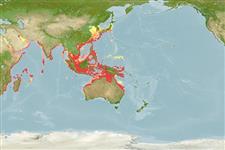>
Carangiformes (Jacks) >
Carangidae (Jacks and pompanos) > Caranginae
Etymology: Parastromateus: Greek, para in the side of + Greek, stromatos = a fish flattened body with a lot of colours (Stromateus sp.) (Ref. 45335).
More on author: Bloch.
Environment: milieu / climate zone / depth range / distribution range
Ekologi
marina; brackvatten revassocierade; amfidrom (Ref. 51243); djupintervall 15 - 105 m (Ref. 12260), usually 15 - 40 m (Ref. 54702). Tropical; 42°N - 30°S, 32°E - 154°E
Indo-West Pacific: East Africa to southern Japan and Australia.
Length at first maturity / Size / Vikt / Age
Maturity: Lm 23.0, range 22 - 24 cm
Max length : 75.0 cm TL hane/ej könsbestämd; (Ref. 5284); common length : 30.0 cm TL hane/ej könsbestämd; (Ref. 3287)
Taggstrålar i ryggfenan (totalt): 2 - 6; Mjukstrålar i ryggfenan (totalt): 41-46; Taggstrålar i analfenan 2; Mjukstrålar i analfenan: 35 - 40; Ryggkotor: 24. Deep-bodied and strongly compressed fishes. Lateral line ends in weakly-developed scutes on the caudal peduncle. Pelvic fins lost in individuals over 9 cm. Color is brown above, silvery-white below. The anterior parts of the dorsal and anal fins bluish-gray. The other fins yellowish.
Adults inhabit coastal areas with muddy substrate. Found near the bottom during daytime and near the surface at night. They also enter estuaries (Ref. 1479). Normally form large schools (Ref. 5213). Swim on its side near the surface (Ref. 3197). Feed on zooplankton (Ref. 30573). Excellent food fish (Ref. 3197); marketed fresh, may be dried or salted (Ref. 5284).
Paxton, J.R., D.F. Hoese, G.R. Allen and J.E. Hanley, 1989. Pisces. Petromyzontidae to Carangidae. Zoological Catalogue of Australia, Vol. 7. Australian Government Publishing Service, Canberra, 665 p. (Ref. 7300)
IUCN Red List Status (Ref. 130435)
Threat to humans
Harmless
Human uses
Fiskeri: kommersiellt viktig
Verktyg
Special reports
Download XML
Internet-källor
Estimates based on models
Preferred temperature (Ref.
123201): 24.3 - 29.1, mean 28.1 °C (based on 1436 cells).
Phylogenetic diversity index (Ref.
82804): PD
50 = 1.0000 [Uniqueness, from 0.5 = low to 2.0 = high].
Bayesian length-weight: a=0.02570 (0.02118 - 0.03119), b=2.89 (2.83 - 2.95), in cm total length, based on LWR estimates for this species (Ref.
93245).
Trofisk nivå (Ref.
69278): 2.9 ±0.35 se; based on food items.
Resiliens (Ref.
120179): Mellan, lägsta populationsfördubblingstid 1,4-4,4 år (K=0.6; Fec=1,692).
Prior r = 0.57, 95% CL = 0.37 - 0.85, Based on 15 stock assessments.
Fishing Vulnerability (Ref.
59153): Low to moderate vulnerability (30 of 100).
Climate Vulnerability (Ref.
125649): Very high vulnerability (86 of 100).
Nutrients (Ref.
124155): Calcium = 125 [23, 264] mg/100g; Iron = 0.892 [0.342, 2.262] mg/100g; Protein = 19.7 [18.3, 21.0] %; Omega3 = 0.112 [0.065, 0.213] g/100g; Selenium = 50.6 [24.2, 118.5] μg/100g; VitaminA = 27.8 [6.4, 116.0] μg/100g; Zinc = 0.594 [0.337, 1.944] mg/100g (wet weight); based on
nutrient studies.
